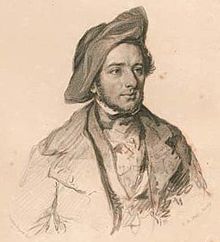– By Jeff Koch
The Start.
Over 150 years ago, the man called the “first celebrity chef” got his start in his native France. Born in 1810, Alexis Soyer had star power, looks, and a gift for storytelling and self-promotion. But more importantly, he was a master of the culinary arts and an inventor whose innovations improved cooking methods and lives.
 He began his training at age 11 in Paris. In 1830 he began cooking in the Foreign Office just before the Second Revolution. One evening, a mob broke in, killing a number of workers. Soyer began singing La Marseillaise, and was spared and carried from the kitchen by the mob, but his association with the old order made it difficult for him to remain in Paris. So in 1831 he left for the England where French chefs were in demand.
He began his training at age 11 in Paris. In 1830 he began cooking in the Foreign Office just before the Second Revolution. One evening, a mob broke in, killing a number of workers. Soyer began singing La Marseillaise, and was spared and carried from the kitchen by the mob, but his association with the old order made it difficult for him to remain in Paris. So in 1831 he left for the England where French chefs were in demand.
Big Changes.
After cooking in various English country homes, including those of the Dukes of Cambridge and Sutherland and the Marquis of Waterford, Soyer landed in London. In 1837 he became the master chef at London’s Reform Club. There he designed a new kitchen with innovations such as the first use of gas and variable temperature ovens. Soyer created numerous new dishes in a style that made him the top chef in London. He is also credited with creating the first fish and chips. The club still serves Soyer’s recipe for Lamb Cutlets Reform.
Soyer had a deep interest in helping the poor and designed portable soup kitchens which did great service in the Irish potato famine. His soup kitchen in Ham Yard, Haymarket one Christmas fed 22,000 people. He also produced some of the first cookbooks for the poor and middle class, as well as The Pantropheon, a history of cooking going back to the Greeks and Romans. His thoughts on healthy, nutritious food were in line with much of ours today – fresh vegetables and fish, in contrast with the typical English diet in the Victorian age.
After leaving the Reform Club in 1850, he helped the British Navy overcome problems with canned meat by changing portions, methods, and ingredients. In 1853 during the Crimean War, the English Army was ill-prepared to supply its army and to treat the sick and wounded. Accounts of the terrible conditions and of Florence Nightingale’s heroic service reached Soyer in London, and he offered to reform the cooking practices of the army and its hospitals to improve the health and morale of the army.
Renovations.
Soyer made great improvements to the sanitary conditions and quality of the food in hospitals and field kitchens using little more than existing army rations. He designed a new field stove that used only 10% of the fuel needed for cooking over open fires or fire pits, hid the fire from enemy view, and could be used to cook soups or bread. When used indoors, it also provided heat to quarters in the winter. His Scutari teapot enabled the preparation of coffee and tea in large volumes and was in use until the 1950s. His recommendations eventually led to the establishment of professional cooks in the British military.
He was a colorful and popular figure whose service was recognized by the military, physicians, and press. The effects of illnesses during his army service, his lifestyle, and a fall from a horse took a toll on him, but he kept a heavy schedule of demonstrations, lectures, instruction, and cooking until his health failed him for good. On August 5, 1858, Alexis Soyer died at the age of 48. The great celebrity chef slipped quietly into obscurity, largely forgotten to history.
Jeff Koch is a history geek living in Brentwood, Tennessee. He is a member of the Freolac Club and a World War II Study group. He focuses on military and business history and came across Chef Soyer while reading John Selby’s excellent book about the Crimean War, The Thin Red Line.
Please note that I do not and will not take compensation from individuals or companies I mention or promote in my blog.
Are you following us on Facebook and Twitter?
Copyright © 2014 Stew Ross

